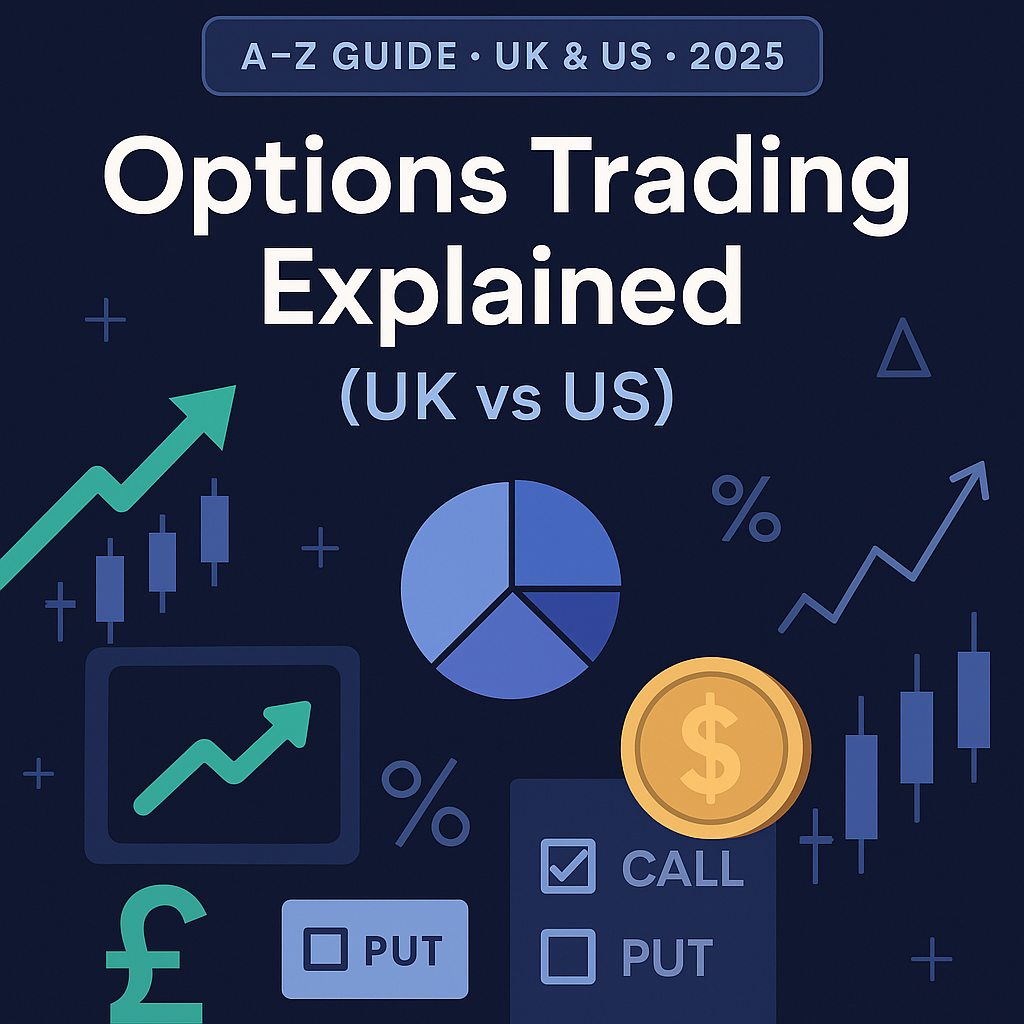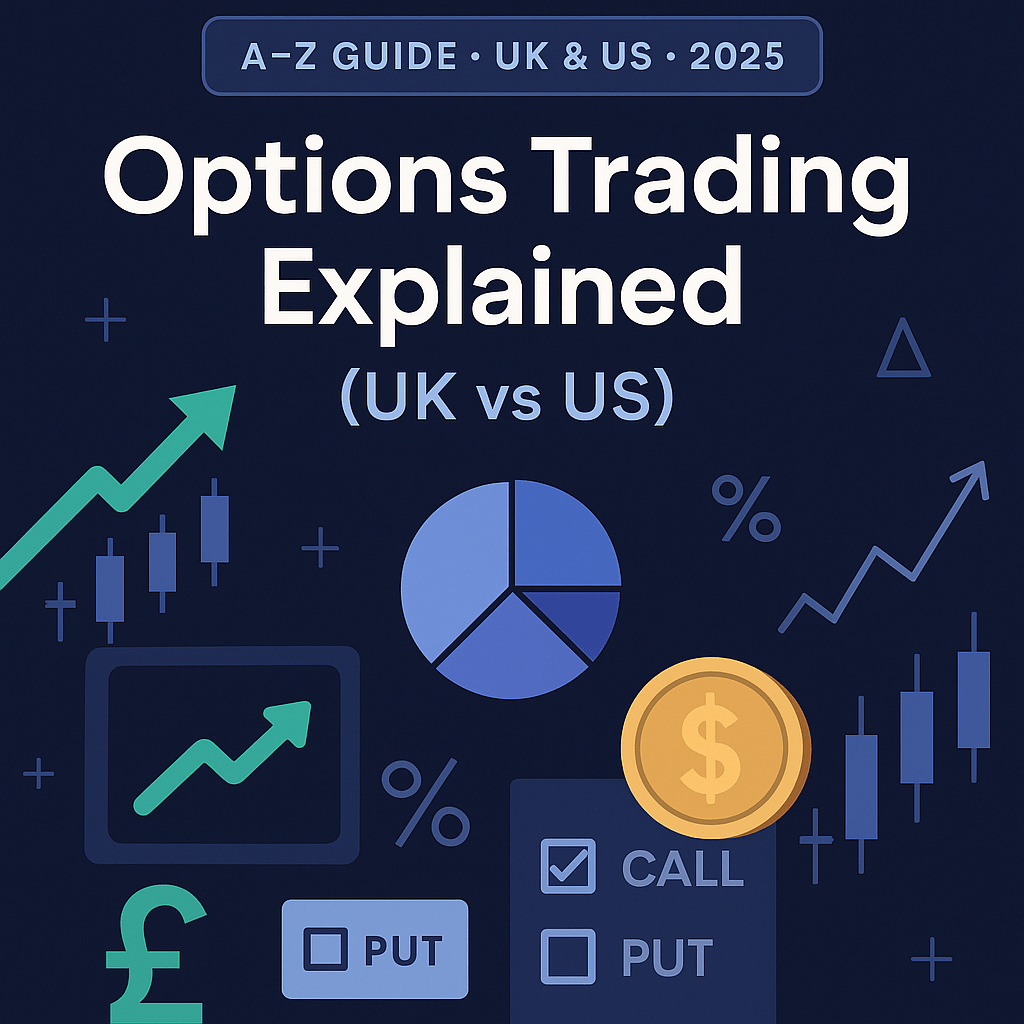Options Trading Explained (UK vs US)
Clear, direct, and practical. This guide takes you from basic definitions to advanced strategies with UK and US regulations in mind. No fluff. Just what you need to place smarter trades.
Primary keyword: options trading explained. Secondary: UK trading, US trading, for beginners, guide, strategies.
Why trade options?
Options can control risk, generate income, and structure trades with defined outcomes. Most beginners struggle with jargon, assignment risk, and platform settings. This guide fixes that with plain language and concrete steps.
- Not sure what delta, theta, or assignment really mean.
- Confused about FCA vs SEC rules and which brokers to use.
- Unclear how to size a trade or cap losses.
- Need a simple routine to find and manage setups.
Options basics and key terms
An option is a contract that gives you the right, not the obligation, to buy or sell an underlying asset at a set price before a set date.
Call Option
Right to buy. You expect the price to rise.
BullishPut Option
Right to sell. You expect the price to fall or want protection.
Bearish / HedgeStrike & Expiry
Strike is the agreed price. Expiry is the last day the option is valid.
Contract termsThe Greeks in one minute
How options work: step-by-step
- Select the underlying. Pick liquid names: AAPL, MSFT, SPY, FTSE 100 ETFs, or major FX/Index options where available.
- Define your thesis. Directional, income, or hedge. Write it in one sentence.
- Choose strategy. Calls/puts, spreads, or covered calls based on risk and view.
- Pick expiry and strike. For long options, buy more time than you think you need. For income trades, choose strikes outside recent ranges.
- Plan risk. Max loss, max profit, break-even. Put it in your journal before you trade.
- Execute with limit orders. Avoid chasing wide bid-ask spreads.
- Manage the position. Take partial profits, roll or close when risk/reward changes.
Position size (contracts) ≈ (Account Risk $) ÷ (Max Loss $ per contract) Example: Account $10,000, risk 1% = $100. If a debit spread max loss = $50, contracts ≈ 2.
UK vs US: rules, brokers, and taxes
- Equity and index options available through FCA-authorised brokers. Retail leverage is embedded in the option price, not via margin like CFDs.
- CFD and spread-bet products are common. For options, ensure the broker explicitly supports listed options with robust risk tools.
- Tax: Share dealing profits may be subject to Capital Gains Tax. Spread betting can be tax-free for many residents. Always confirm with HMRC guidance.
- SEC and FINRA regulate securities. Brokers require Options Approval Levels for strategies from covered calls up to advanced spreads.
- Pattern Day Trader rule affects frequent intraday stock trading. Options day trades can still count toward PDT in margin accounts.
- Tax: Options gains are usually short-term unless specific treatments apply. Section 1256 applies to some index options/futures. Speak with a CPA.
Popular broker considerations
- Platform depth: option chains, Greeks, probability tools, and risk curves.
- Fees: per-contract pricing, assignment/exercise, and regulatory fees.
- Order types: OCO, bracket exits, conditional orders.
- Support: 24/5 desk during earnings and event risk.
Core strategies with UK/US examples
Covered Call (Income)
Hold 100 shares and sell a call above current price. Collect premium while capping upside.
- Best when: Neutral to slightly bullish.
- UK/US example: 100 shares of a FTSE 100 or S&P 500 constituent, sell a 30–45 DTE call ~0.20–0.30 delta.
Cash-Secured Put (Entry at a Discount)
Sell a put at a strike where you are happy to buy shares. Keep cash reserved.
- Best when: Neutral to moderately bullish.
- Tip: Target annualised return that beats your hurdle while respecting assignment risk.
Long Call / Long Put (Directional)
Simplest directional bet with defined risk. Buy more time than you think you need to reduce theta drag.
- Best when: Expect a strong move or catalyst.
- Entry: 45–90 DTE, 0.35–0.50 delta, limit order mid-price.
Debit Spread (Defined Risk)
Buy one option and sell another further out to reduce cost and theta. Caps profit and loss.
- Use: Trend continuation with moderate targets.
- Manage: Take profits near 50–75% of max.
Iron Condor (Range)
Sell an out-of-the-money call spread and put spread. Profit if price stays inside the range.
- Best when: Low volatility ranges, post-catalyst.
- Risk: Gap risk around earnings and macro events.
Protective Put (Hedge)
Own shares and buy a put below. Acts like insurance with a known deductible.
- When: Heading into risky events or volatility spikes.
Example: Debit call spread on a large-cap
You expect a steady grind higher, not a moonshot. Buy a 60 DTE 0.45 delta call and sell a 0.25 delta call. You reduce cash outlay and theta. Max loss equals net debit.
Risk management and sizing
- Fixed fractional risk: 0.5%–1% of account per idea keeps drawdowns survivable.
- Correlations: Treat highly correlated names or indices as one risk unit.
- Max portfolio risk: Keep total defined risk at or below 5% in volatile weeks.
- Time risk: Theta accelerates in the last 21 days. Close or roll earlier.
- Liquidity: Target tight markets with penny-wide increments where possible.
Debit spread example: Account: £/$10,000 Risk per trade: 1% = £/$100 Max loss per spread = £/$50 → Contracts = 2
Playbook: your weekly routine
Watchlist build (Sunday or Monday)
- Scan for trend strength, ranges, and catalysts in FTSE 100, S&P 500, Nasdaq names, and liquid ETFs.
- Note earnings dates and economic events for UK and US.
Setups to hunt
- Breakout with volume: Use debit spreads or long calls.
- Range after event: Consider iron condors with conservative strikes.
- Pullback to support: Cash-secured puts or covered calls.
Pre-trade checklist
- Defined thesis in one sentence.
- Strategy selected with max loss known.
- Expiry and strike chosen with liquidity checked.
- Position size calculated; total portfolio risk in limits.
- Exit and roll rules written in your journal.
FAQs
Is options trading suitable for beginners?
Yes if you start with defined-risk trades and small size. Use a demo first, then move to real capital only after consistent





